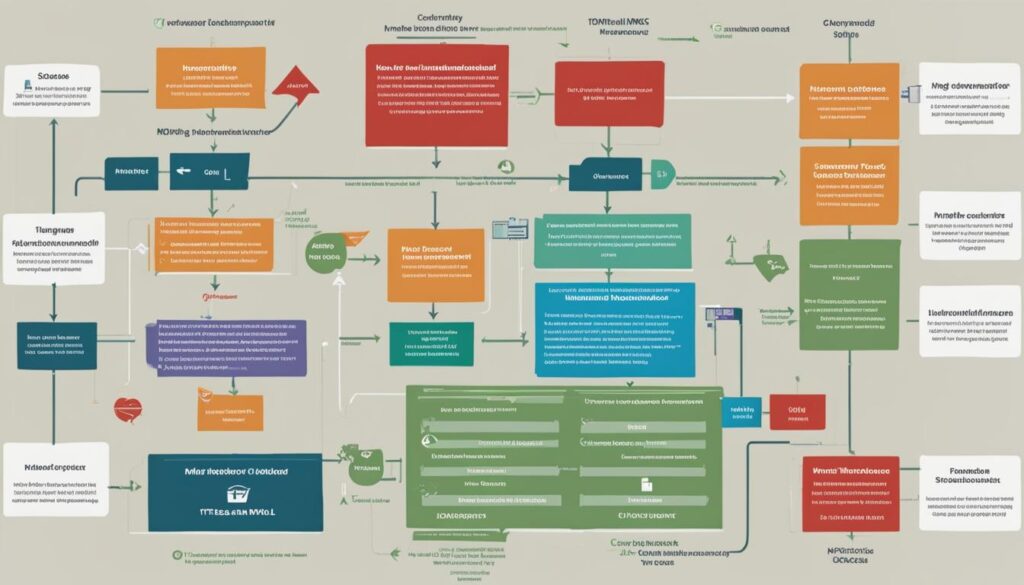If you’re facing the challenges of an HMRC tax avoidance settlement and looking to resolve tax issues in the most efficient way possible, our comprehensive tax settlement guide is here to help. We’ll walk you through various aspects of tax dispute resolution, including understanding the settlement process, identifying avoidance schemes, and successfully negotiating with HMRC in order to successfully navigate your tax affairs.
First, let’s dive into the latest developments that underpin these settlement opportunities, including the 2020 updates to the HMRC’s tax avoidance settlement terms.
Understanding HMRC Tax Avoidance Settlements
HMRC’s tax avoidance settlements focus on addressing the issues surrounding disguised remuneration schemes. These schemes typically offer loans that are not intended to be repaid, leading to tax avoidance. Through the tax settlement scheme, HMRC aims to provide clarity and resolution for all parties involved. The settlement process is specifically tailored to ensure efficient and transparent handling of tax liabilities associated with these schemes.
Various factors can impact a taxpayer’s settlement, including their classification as a contractor, employer, or employee. HMRC takes into account each party’s specific circumstances when determining the settlement terms. The classification has a direct influence on the Income Tax, National Insurance contributions, late payment interest, penalties, and potentially, Inheritance Tax dues associated with the tax settlement.
It is essential for individuals to have a clear understanding of tax settlements and the impact of various factors on their agreement with HMRC. By grasping the distinctions among contractor, employer, and employee classifications, taxpayers can make informed decisions about resolving their tax affairs and negotiating a favorable settlement agreement.
Since settlement terms can differ significantly, having a solid understanding of the HMRC settlement agreement process is crucial for successfully resolving tax disputes. This knowledge can help individuals navigate the complexities associated with tax avoidance schemes, ensuring they stay compliant with tax laws and receive fair treatment from HMRC.
It’s worth noting that successfully handling tax avoidance settlements doesn’t only benefit taxpayers. By addressing disguised remuneration schemes, HMRC can safeguard revenue streams for the public purse and ensure that everyone pays their fair share of taxes, leading to a more equitable tax system for all.
Identifying Tax Avoidance Schemes

Identifying tax avoidance schemes can be challenging, given the diverse tactics and strategies utilized by those who attempt to evade taxes. However, there are certain indicators of tax avoidance schemes that can help taxpayers spot potential malpractice and protect themselves from inadvertently participating in unlawful activities.
One key indicator is when a scheme offers a substantially higher take-home pay than what is expected based on one’s income and deductions. This can signal an arrangement designed to reduce one’s tax liabilities by exploiting loopholes in tax regulations or deliberately misrepresenting income.
Involvement with umbrella companies that break tax rules is another red flag. Umbrella companies are intermediaries that contract with individual workers and their employers, consolidating payroll and administrative functions. While many umbrella companies operate legally, some engage in dubious practices to avoid taxes. Therefore, it is essential to scrutinize any contracts and agreements connected to these companies.
Contractual anomalies may also suggest the presence of a tax avoidance scheme. Examples include unclear provisions relating to income and/or expenses, multiple contracts for the same work, non-standard clauses designed to lower the tax burden, or contracts that do not match the nature of the work performed.
Significant pay discrepancies between the amounts shown on bank statements and payslips are concerning as well, as they may indicate untaxed payments or other questionable activities. Furthermore, any untaxed loans or capital advances received should be scrutinized, as they could be part of a tax avoidance scheme.
Lastly, involvement with named tax avoidance schemes is another clear sign of nefarious behavior. HMRC continually updates its list of identified tax avoidance schemes, so taxpayers can review the list to ensure they are not unknowingly participating in any such arrangements.
Vigilance and verifying pay setups can go a long way in protecting oneself from inadvertently participating in tax avoidance schemes. Staying informed and proactively investigating any suspicious financial activities will help ensure compliance with tax laws and prevent the unpleasant consequences associated with tax avoidance.
Steps to Take Before Negotiating a Settlement

Before negotiating an HMRC tax settlement, individuals should take several important steps to ensure the best possible outcome. This includes familiarizing oneself with the HMRC settlement terms, compiling necessary documentation, and seeking professional tax advice. The following subsections provide a more in-depth look at these steps.
Familiarize Yourself with HMRC Settlement Terms
Understanding the differences in settlement terms for contractors, employers, and employees is integral when dealing with HMRC tax disputes. Be aware of possible obligations, such as Income Tax, National Insurance contributions, and potential penalties. Additionally, it is important to identify if any reduced liabilities apply based on previous tax payments. Acquainting oneself with the HMRC settlement terms will provide a solid foundation for tax settlement preparation.
Compiling Necessary Documentation
Gathering and organizing relevant tax documents is a critical step in the settlement process. Information required by HMRC includes the names and amounts of disguised remuneration schemes used, scheme reference numbers, relevant tax years, and loan amounts. Employers must also provide contribution details and individual identifiers for those who received loans. Properly compiling tax documents and settlement documentation streamlines tax dispute paperwork, ensuring a smoother negotiation process.
Seeking Professional Advice
When navigating complex tax disputes or situations involving employer insolvency, seeking tax advice becomes crucial. Receiving professional tax guidance and tax avoidance advice can assist individuals in understanding the legal implications of their situation and ensure the most favorable outcomes while remaining in compliance with the law. Such expertise can make a significant difference when negotiating an HMRC tax settlement.
How to Provide Settlement Information to HMRC

When it comes to providing settlement information for the HMRC tax settlement process, individuals and employers need to follow specific submission procedures. The goal is to facilitate an efficient assessment of the case and to expedite the resolution of tax affairs. To submit tax settlement details, follow the steps detailed below.
Firstly, individuals should complete and submit their details using the official online form provided by HMRC. The form captures essential information related to the individual’s tax affairs and allows for the electronic submission of the required details. By using this designated platform, individuals ensure a smooth and secure transfer of tax information to HMRC.
Employers, on the other hand, are required to send their settlement information via email to a specified address. This method allows a more direct line of communication with HMRC, enabling them to assess the provided details accurately and promptly.
Regardless of whether you are an individual or an employer, it is crucial to gather and organize all necessary documentation and financial information before initiating the submission process. This includes information such as names, amounts of disguised remuneration schemes used, scheme reference numbers, relevant tax years, and outstanding loan amounts. Employers should also provide additional details such as individual identifiers for those who received loans and records of any contributions made.
By thoroughly preparing the required tax settlement documents, you will not only optimize HMRC’s assessment but also facilitate a more efficient tax settlement process. This concerted effort will ultimately lead to a faster resolution of any outstanding tax issues and allow for a more favorable outcome for all parties involved.
Different Settlement Terms for Contractors, Employees, and Employers

The HMRC settlement terms differ depending on an individual’s classification as a contractor, employee, or employer. Each status carries unique tax obligations and liabilities, reflecting the specific needs and responsibilities of these parties in settling tax affairs related to disguised remuneration schemes. Understanding the nuances of HMRC settlement terms is crucial for contractors, employees, and employers to identify their tax responsibilities and plan accordingly.
Contractor tax obligations generally involve fulfilling Income Tax and National Insurance contributions on disguised remuneration loans, as well as paying any late payment interest and potential penalties. Employees, on the other hand, might also be responsible for fulfilling their Income Tax dues, National Insurance contributions, and potential penalties. These responsibilities, however, may differ if the employer already settled or declared these amounts previously.
Employer tax settlement primarily includes settling outstanding Income Tax, National Insurance contributions, late payment interest, and potential penalties for the entire workforce. Additionally, employers may be held responsible for any Inheritance Tax that resulted from their role in the tax avoidance scheme.
In certain cases, the reduction in tax liabilities may apply based on past payments and declarations made by either employees or the employer. This relief is critical in navigating the complexities of the tax settlement process and maximizing the potential benefits of engaging with HMRC to resolve outstanding tax affairs.
In conclusion, understanding the distinct HMRC settlement terms for contractors, employees, and employers is pivotal in identifying and fulfilling contractor tax obligations and employer tax settlement requirements. Proactively engaging with HMRC, seeking professional advice, and adhering to the specific settlement terms can ultimately lead to smooth tax dispute resolution and compliance with the law.
Calculating Your Settlement Amount

When it comes to resolving tax disputes, determining the accurate amount for a tax settlement is a crucial step. By using the appropriate tools, such as the HMRC tax settlement calculator, you can estimate the amount you owe accurately and efficiently. The calculator takes various factors into account when calculating tax settlement amounts, ensuring you have a clear understanding of your financial obligations.
Using the HMRC Tax Settlement Calculator
The HMRC tax settlement calculator is a practical tool to assist in calculating your tax settlement with precision. The calculator considers multiple factors, including:
- Loan amounts
- Tax bands and rates for the relevant years
- Reductions based on previously declared benefits in kind
- Payments like scheme fees
To experience the full benefits of the HMRC tax settlement calculator, it is crucial to gather all the necessary financial information and ensure accuracy in the values you input. By understanding and considering these factors in your calculating tax settlement process, you can rest assured that your estimated tax settlement amount is in line with your actual financial obligations.
In conclusion, having an accurate tax settlement amount is essential for resolving any tax disputes with HMRC. The HMRC tax settlement calculator simplifies this process by considering various factors to provide a precise tax settlement estimation. By utilizing this tool, you can make an informed decision and be better equipped to reach a fair agreement with HMRC.

When participating in tax avoidance schemes, individuals and businesses might face severe repercussions, including the repayment of due tax, interest, and potential penalties. The amount to be repaid is determined by numerous factors, such as the type of scheme used and the individual’s circumstances. When it comes to dealing with tax avoidance, HMRC’s primary intention is to resolve these issues and not to punish genuine mistakes. As a result, seeking resolution and following the guidelines provided by HMRC is advised for those looking to navigate the penalties associated with tax avoidance.
To successfully avoid HMRC tax penalties, it’s essential to be proactive in addressing any tax avoidance issues that may arise. Working towards a settlement with HMRC demonstrates a willingness to correct past mistakes and ensures future compliance with tax laws. Understanding the tax avoidance penalty structure and knowing one’s liabilities are crucial in remedying the situation.
HMRC penalties navigation can prove to be complex, which is why seeking professional advice is highly recommended. Tax experts and legal professionals can provide guidance on understanding the intricacies of tax avoidance penalties and help to negotiate a suitable settlement with HMRC. This assistance can be invaluable in avoiding additional financial hardships and ensuring compliance with tax legislation moving forward.
Utilities of ADR in Tax Dispute Resolution

Alternative Dispute Resolution (ADR) serves as a valuable tool in resolving tax disputes by facilitating discussion and settlement or preparing for litigation. ADR aims to aid both parties in reaching an understanding or agreement, potentially avoiding the need for court proceedings. The use of ADR in tax dispute resolution offers numerous advantages over traditional litigation, including reduced costs, quicker resolution times, and a more flexible approach to finding mutually beneficial solutions.
ADR tax dispute resolution can take the form of mediation, where a neutral third-party mediator helps the disputing parties find common ground and reach an agreement. Mediation is often a less adversarial process than litigation and encourages open communication between the parties. It can be particularly helpful in cases where preserving long-term relationships is crucial, such as disputes involving business partners or employers and employees.
Another form of ADR is arbitration, where the disputing parties agree to binding arbitration, engaging an independent arbitrator to hear the case and render a decision. While more formal than mediation, arbitration can still be a faster and less expensive process than going to court. In both mediation and arbitration, the parties maintain a greater level of control over the process and the ultimate resolution, which may lead to more satisfactory outcomes for all involved.
Tax dispute negotiation through ADR can be an effective method to resolve disputes with HMRC, as it allows both parties to avoid the time, expense, and stress of litigation. ADR provides an opportunity for open discussion and problem-solving, which can lead to a greater likelihood of compliance with tax obligations and ultimately, a more fair and efficient resolution.
In conclusion, the utilization of ADR in tax dispute resolution can lead to quicker, more cost-effective, and satisfactory outcomes for both taxpayers and HMRC. By embracing alternative dispute resolution methods, such as mediation and arbitration, parties can work together more cooperatively to reach agreements and resolve tax disputes, avoiding potentially lengthy and costly court battles.
HMRC’s Approach to Litigation and Settlement

HMRC values a fair and efficient approach to addressing tax disputes. Their primary goal is to secure the best possible outcomes for all parties, complying with the law, and ensuring consistency in the process. HMRC’s Litigation and Settlement Strategy (LSS) provides a framework to guide both parties involved in the tax dispute litigation, emphasizing clarity and transparency throughout the tax settlement litigation process.
Understanding the Litigation and Settlement Strategy
The LSS governs the way HMRC manages tax disputes and is designed to secure the best practicable return for the Exchequer while maintaining fairness and consistency. The strategy mandates diligent management of disputes with the aim of reaching a resolution in line with the law, either through agreement or litigation. Collaborative efforts between the involved parties allow for dispute settlement through open negotiation that considers the unique merits of each case.
Potential Outcomes of HMRC Litigation
HMRC litigation outcomes are varied and can range from the complete payment of assessed liability to negotiated settlements with the liable party. Factors such as efficiency, impact on revenue flows, Exchequer interests, and the deterrent effect on non-compliance play a significant role in shaping the outcome of each dispute. HMRC considers these factors carefully when assessing individual tax dispute cases.
Concurrent resolution of multiple disputes is possible; however, each dispute is assessed independently based on its merits and specific circumstances. This approach ensures fairness and resource efficiency for all parties involved in the tax settlement litigation process.
Payment Options for Your Tax Settlement

HMRC understands that settling tax liabilities can be a financial burden for some taxpayers. To help ease this burden, various tax settlement payment options are available to accommodate individual needs and financial situations.
For taxpayers with an income below certain thresholds, HMRC offers installment arrangements without the need for detailed financial disclosure. This payment option allows those experiencing financial difficulty to repay their tax liabilities in smaller, periodic installments. This approach offers respite for taxpayers while demonstrating their commitment to resolving tax obligations.
In cases where higher incomes or longer payment periods are requested, more detailed financial information will have to be submitted to HMRC. A thorough assessment of the taxpayer’s financial situation determines the feasibility of their proposed payment arrangements. Factors such as monthly disposable income, assets, and dependents are taken into account when determining the installment payment amount and frequency.
Regardless of the chosen HMRC payment arrangements, it is always recommended that taxpayers prioritize settling their tax liabilities as soon as possible, to avoid potential penalties and interest costs. Timely resolution of tax disputes minimizes complications and helps maintain a transparent relationship with HMRC.
How to Protect Yourself from Future Tax Avoidance Schemes

To safeguard oneself from potential future tax avoidance schemes, it is crucial to be aware of the indicators and resources that help improve tax compliance. By recognizing the signs of tax schemes and utilizing available tax compliance assistance, individuals can make informed decisions and avoid involvement in illegitimate tax arrangements.
Indicators of Tax Avoidance Schemes
Various red flags may indicate that a tax arrangement could be a tax avoidance scheme. To spot tax avoidance indicators, consider the following:
- Payments you receive do not match the figures on your payslip.
- Untaxed loans or capital advances are being used as a form of remuneration.
- Pay arrangements seem convoluted or too good to be true, often promising significantly higher take-home pay.
- Umbrella companies or other intermediaries are involved, and they seem to be breaking tax rules.
Remaining vigilant and understanding how your pay is received, whether through umbrella companies or other means, can help prevent inadvertent participation in tax avoidance schemes.
Resources to Improve Tax Compliance
HM Revenue and Customs (HMRC) offers various resources and guidelines to assist taxpayers in identifying and steering clear of tax avoidance. These resources play a pivotal role in improving tax compliance and supporting taxpayers in making informed decisions:
- Risk checkers: Tools designed to assess the legitimacy of tax arrangements and help taxpayers determine if they are likely to be involved in tax avoidance.
- Lists of named tax avoidance schemes: HMRC publishes lists of known tax avoidance schemes to help taxpayers identify arrangements they should avoid.
- Guides on umbrella companies: Publications that provide information on how legitimate umbrella companies operate, enabling taxpayers to differentiate between compliant and non-compliant entities.
By familiarizing oneself with these resources, taxpayers can effectively protect themselves from falling prey to future tax avoidance schemes and ensure their tax affairs remain compliant with the law.
Success Stories: Settling Tax Disputes with HMRC

Settling tax disputes with HMRC can appear daunting, but numerous success stories demonstrate that cooperation, compliance, and a proactive approach can result in favorable outcomes. In these cases, individuals and companies have resolved their tax avoidance issues by working closely with HMRC and adhering to the tax settlement terms.
One standout example is a small business owner who uncovered irregularities in their financial records, indicating participation in a tax avoidance scheme. Upon discovering the issue, the business owner promptly contacted HMRC and commenced negotiations. By taking the initiative and cooperating with the authorities, the owner successfully resolved the dispute and safeguarded the company’s reputation.
Another inspiring tax dispute resolution success is the case of a contractor who was unknowingly involved in a disguised remuneration scheme. Upon learning about the scheme, the contractor quickly sought professional advice and contacted HMRC. Following a thorough investigation and transparent discussions, HMRC agreed to a fair settlement that allowed the contractor to put the issue behind them and continue their career without the burden of potential penalties.
These HMRC settlement stories showcase the benefits of proactively engaging with tax authorities and meeting tax obligations to resolve disputes. By opting for a sincere and open approach, individuals and companies can achieve positive outcomes and move forward with confidence, avoiding the consequences associated with tax avoidance.
Frequently Asked Questions
What are HMRC tax avoidance settlements?
HMRC tax avoidance settlements offer a route for individuals and companies to resolve their tax affairs, potentially avoid larger tax liabilities and penalties, and move away from tax avoidance for good. These settlements are specific to disguised remuneration schemes and aim to provide clarity and resolution to involved parties.
How can I identify tax avoidance schemes?
Indicators of tax avoidance schemes include substantially higher take-home pay, involvement with umbrella companies that break tax rules, and contractual anomalies. Pay discrepancies between bank accounts and payslips, untaxed payments, and involvement with named avoidance schemes are clear signs. Being vigilant and verifying pay setups can help protect against inadvertent participation in avoidance schemes.
What steps should I take before negotiating a tax settlement with HMRC?
Before negotiating a tax settlement, familiarize yourself with HMRC’s settlement terms and understand the differences for contractors, employers, and employees. Compile necessary documentation such as scheme reference numbers, relevant tax years, and loan amounts. Seeking professional advice is strongly recommended, particularly in complex cases or situations involving employer insolvency.
How do I provide settlement information to HMRC?
To provide HMRC with settlement information, individuals should submit details electronically using the online form provided by HMRC. Employers should email their information to a specified address. Preparing documentation and financial information ahead of time facilitates the HMRC assessment and moves the settlement process forward.
What is the HMRC tax settlement calculator?
The HMRC tax settlement calculator is a tool offered by HMRC to assist in estimating settlement amounts. Factors considered include loan amounts, tax bands and rates for relevant years, and reductions based on previously declared benefits in kind and payments like scheme fees. Accurate calculation is crucial to determine the final settlement value.
What are the penalties for participating in a tax avoidance scheme?
Penalties for participating in tax avoidance schemes can include repayment of due tax, interest, and potential penalties. The amount is determined by factors such as the type of scheme used and the individual’s circumstances. HMRC’s intention is to tackle avoidance and not to punish genuine mistakes, so seeking resolution is advised.
What is Alternative Dispute Resolution (ADR)?
Alternative Dispute Resolution (ADR) is a tool used in resolving tax disputes by facilitating discussion and settlement or preparing for litigation. ADR aims to help both parties reach an understanding or agreement, potentially avoiding the need for court proceedings.
How does HMRC approach litigation and settlement?
HMRC’s Litigation and Settlement Strategy (LSS) outlines how tax disputes should be handled, promoting resolution in line with the law, either through agreement or litigation. The goal is to ensure the best practicable return for the Exchequer while being fair and consistent. Outcomes of litigation may range from full payment of assessed liability to negotiated settlements.
What payment options are available for tax settlements?
HMRC provides various payment options, including installment arrangements without the need for detailed financial disclosure for those with incomes below certain thresholds. For higher incomes or longer payment periods, more detailed financial information is required. Settlements can be paid in installments, factoring in disposable income.
How can I protect myself from future tax avoidance schemes?
To protect yourself, look for indicators such as payments not matching payslip figures, untaxed loans, or capital advances. Vigilance and understanding how pay is received, whether through umbrella companies or otherwise, can prevent involvement in avoidance schemes. Familiarize yourself with HMRC resources and guidelines to identify and steer clear of tax avoidance.
The Bottom Line
Resolving HMRC tax disputes through the tax avoidance settlement process provides a clear and structured method for individuals and companies to settle their tax affairs. By understanding the terms of the settlement, providing diligent settlement information, and seeking professional advice, involved parties can efficiently navigate this process and achieve favorable outcomes. Embracing compliance with HMRC guidance is essential in preventing future involvement in tax avoidance schemes, ensuring alignment with tax laws, and maintaining the integrity of the financial system.
Adherence to the HMRC settlement process is crucial in mitigating potential penalties, interest charges, and additional tax obligations. It is imperative that individuals and companies carefully consider their options, consult with tax professionals, and make informed decisions when resolving tax disputes. Ultimately, engagement in the settlement process demonstrates a commitment to tax compliance and a responsibility towards upholding the law.
Final thoughts on tax settlements emphasize the importance of a proactive approach towards tax compliance. By staying informed about tax laws, seeking professional guidance, and utilizing available resources, individuals and companies can prevent future involvement in tax avoidance schemes and safeguard their financial futures. Committing to tax compliance and a transparent relationship with HMRC benefits not only the individual or company but also supports the fair functioning of the entire system.






